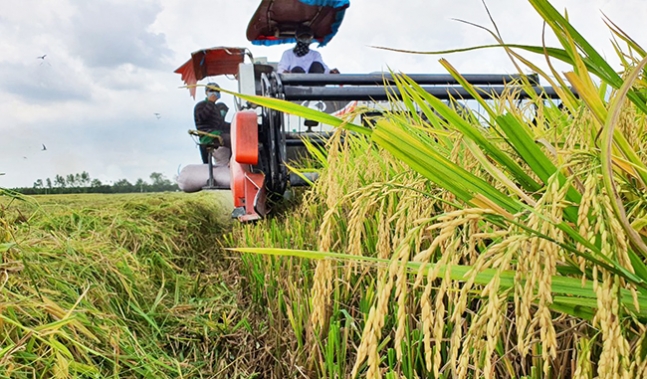Agriculture has been the key economic pillar of the Mekong Delta, and as such, development policies for the region over the years have been designed to bolster agriculture. However, this foundation is becoming weak.
A sinking foundation
Agricultural growth has slowed down since 2005. Between 2001 and 2010, agricultural growth averaged out at over 7% a year, but this growth rate fell by half in the following 10 years, at only 3.5%. The proportion of agriculture in gross regional domestic product has shrunk, and the Mekong Delta’s contribution to the national economy has also tumbled.
The industrial sector was just a scratch in the 1991-2000 period, accounting for only 16% of GRDP, with the annual growth rate lagging behind that of agriculture. However, the sector has since then seen leaps and bounds, with the average annual growth rate hitting 19% in 2000-2010. From 2011 to 2020, industrial development in the Mekong Delta slowed down a bit, but the annual growth rate was still three-fold higher than that of agriculture. The processing industry has become the driving force of the Mekong Delta’s economic growth despite little support in terms of development policies.
Industrial development on infertile soil
The uneven development among the Mekong Delta’s provinces in the past 10 years is due to their respective industrial development. Long An, and later Tien Giang, have attracted much private capital, including foreign direct investment (FDI), into the industrial sector. These two provinces have therefore obtained high economic growth in recent years, resulting in diverse industrial structures, big numbers of new businesses, low unemployment, low rates of migration, and higher income per capita.
FDI is a vital factor of economic growth in the Mekong Delta, with large funds flowing into the processing industry in Long An and Tien Giang, and into fields like thermal and renewable energy elsewhere in the delta. However, the processing industry plays a more important role in creating jobs and a ripple effect for the economy.
Not all provinces can attract investment like Long An and Tien Giang, which enjoy better traffic infrastructure and close proximity to HCMC. But interestingly, industrial facilities have sprung up on infertile soil, which is not suitable for crops. Therefore, several districts with non-arable land have become wealthier due to industrial development. Long An became the early bird, followed by Tien Giang three or four years later, and gradually, processing clusters have taken shape along National Highway 1 in these provinces.
Smaller-scale value chains needed
There are still many types of farm produce and handicrafts in rural areas that are marketable. These items, in spite of small scale, are associated with local resources and endemic to specific localities. Lessons from the development of rice and fishery value chains can apply to small-scale value chains for these items.
The One Commune One Product (OCOP) program can be a good model for developing a dynamic and diverse economy in each rural locality.
The expansion of the local market for products peculiar of localities in recent years will bring about new opportunities for small-scale value chains.
Greater support for industrial development
Experiences from Long An and Tien Giang indicate that to step up industrial development, it is necessary to attract investment including FDI. But the result will be better if policies are designed to attract local capital right in each locality.
The Mekong Delta in its strategy needs to attend more to processing and manufacturing industries as well as handicraft villages in rural areas. Policies should focus on access to land, manpower training, access to credit and the market. Access to land is the hardest issue. Spaces for urbanization and industrial development are limited in an agricultural region like the Mekong Delta. The difficult access to land is due to institutional restrictions that hinder urbanization and industrial and service development of the region, as priorities go to agriculture. If this bottleneck is not removed, the regional economy cannot see a breakthrough, even if traffic infrastructure is further improved.
The proposal for the Mekong Delta from the writer of this article, therefore, is to spare more time and resources for industrial development.









